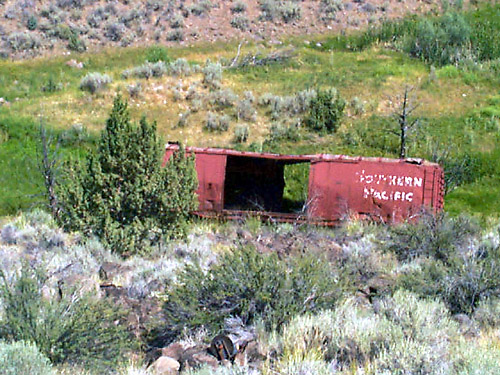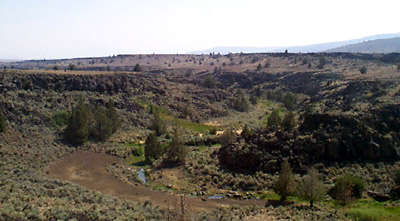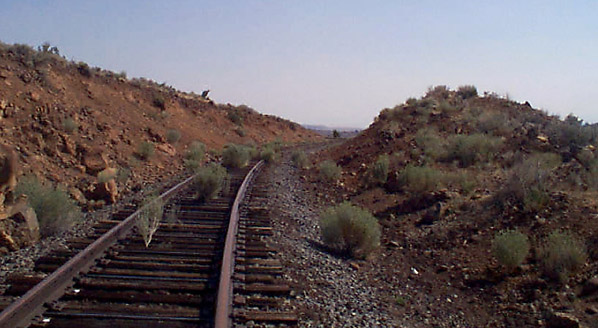
The south end of the disused portion of the Modoc Line runs through some of the wildest and least populated country left in California. From Wendel to Ravendale is nearly 40 miles, yet there are basically only 4 road crossing within that distance. From south to north they are: Wendel Road, Highway 395, Karlo Road, and Horse Lake Road.
Wendel Road a rubbish transfer station so it can be busy at times; without much parking room.
Highway 395 carries a significant volume of traffic most of the time. 395 crosses the rails just north of the old timetable station of Viewland. Karlo Road is a major gravel road in good condition which is well-signed on 395 between Viewland and Ravendale. The crossing is quiet and is at the north end of the Karlo passing track. The foundations of the section house and water tank remain. There is ample room to park out of the way. Horse Lake Road is poorly signed off of 395 about 2 miles south of Ravendale. Carrying little traffic, Horse Lake Road parallels the tracks for a while and then crosses them. Continuing on Horse Lake Road will bring you to Crest. Horse Lake itself is an alkali flat which presently has no water and is not very interesting. It is sort of confusing that the old timetable station of Horse Lake is several miles from the lake itself; and the lake itself does not exist in the traditional form of a place with water in it.
Our trip traversed the portion from Wendel Road on the south, to Horse Lake Road on the north; a rail distance of about 35 miles. Leaving Wendel there is an upgrade on a sweeping curve with spectacular views to the south. On this stretch we saw the biggest antelope we had ever seen, as well as several stretches of the old NCO grade that has been realigned over the years. The passing track at Viewland has been removed (as has the one at Secret), but the red cinder ballast of the sidings remains along the side of the main track at both places. Shortly after Viewland comes the 395 crossing which bears watching due to highway speed traffic; and is difficult to navigate because the rail flange slot is full of pea gravel from road resurfacing. There are long views to the northwest as one heads toward Karlo across about a 5 mile flat.
Leaving Karlo the line shortly enters
the Biscar Wild Life area at a cattle
guard. The federal BLM has put up
an orange plastic fence here to keep
stock out of the reserve. We were
careful to replace it after passing
through. Several miles out of Karlo
we passed Secret where the canyon
of Snowstorm Creek begins to narrow
down. In this narrow section is the
only ranch house that can be seen
from the line. We spoke with the
ranchers along their driveway and
they were severe, but pretty friendly
once they saw that the stock wasn't spooked by the bicycle; and that we weren't bothering their fences or any of their property. Part of the Modoc line is located on federal lands, but a significant amount of it runs through private ranches.


The Modoc Line
Riding the Southern Segment
Nature reclaims its own: Sage and Rabbit Brush in a cut north of Karlo
by Carl O. Block
Note: The Modoc Line ran between Wendel, California and Klamath Falls Oregon and was orginally a part of the Southern Pacific Railroad which took over the old Nevada-California-Oregon narrow gauge early in the 20th century. The N-C-O ran between Wendel and Lakeview, Oregon, and two stories of the northern section of this line were previouly published. There are two excellent sections of the Modoc for railbiking, and Carl describes his findings on the southern segment between Wendel and Ravendale, California.
Snowstorm Creek and gorge.
The line then climbs up out of the Snowstorm Creek drainage onto the flat at Crest. The passing track is still in place at Crest. Heading north out of Crest it is about 3 miles to the Horse Lake road crossing mentioned above. This is the site of a track realignment some years back and you can see the old line paralleling the new on the west. It's sad to think that the present Modoc Line may look like the old alignment in a few years. There are also sweeping views to the north.
An interesting item to watch in spots for is ancient railroad utility poles which appear to have been made on-site out of native juniper trees. Some have rotted off at the base and been reinforced with a newer stub of a pole buried next to the original. A number of these must date from the NCO days as juniper is a very long-lasting wood; particularly in this semi-arid region.
It wasn't allways this quiet on the Modoc line. Wrecked boxcar near Crest.
Hazards to look out for include: 3 dragging equipment detectors, about 8 flange lubricators, petrified cow manure on the rail, and mushroomed rail heads. There are quite a few areas of brush which has grown tall enough to make things difficult.
We had an interesting and pleasant trip with temperatures: daytime-mid 90's, nights mid-60's.
 | ||||||